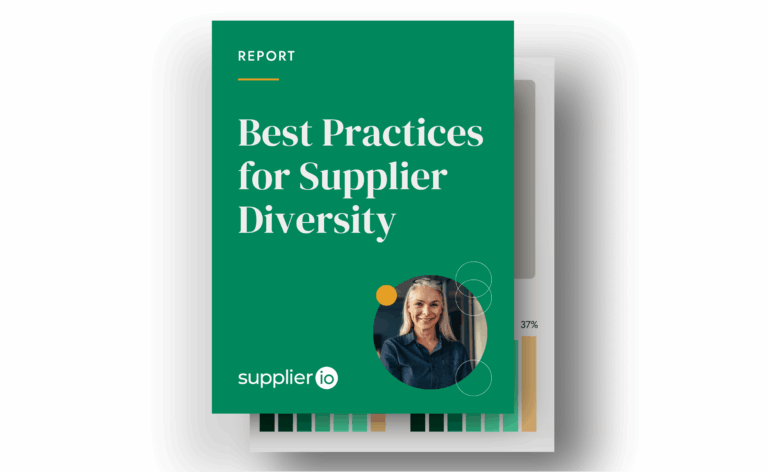How a global Food & Beverage company doubled diverse spend
How better supplier diversity data and processes increased diverse spend reporting by over $100M

Accurate data is the cornerstone of success for any supplier diversity program. However, many organizations struggle with data quality issues that can severely undermine their reporting and, consequently, their program’s effectiveness. Often, these issues can mask the true impact of supplier diversity efforts and leave significant opportunities hidden in plain sight.
But what happens when a global food and beverage company recently addressed these challenges head-on? With the help of IBM Business Process Outsourcing (BPO) Services along with Supplier.io, this company was able to uncover more than $100 million in hidden diverse spend, more than doubling their reported spend metrics. This case study was reviewed in a recent webinar.
Context: Symptoms of Ineffective Data & Reporting
When IBM BPO Services team first engaged with the client, they started by looking for specific warning signs that their data and supplier diversity reporting may be inaccurate. They typically look for:
- Multiple, often incomplete sources of data that lead to inconsistent information
- Insufficient supplier name normalization that creates duplicates or missed connections
- Missing address data that hinders proper supplier identification and classification
- Inadequate filters resulting in misrepresented spend figures
Diversity and digital transformation
IBM was originally engaged as part of a digital transformation for the procurement team. But as they dug into the systems and data, they were able to identify that the company wasn’t capturing all their spend data to report the success of their supplier diversity program.
“We were working with them primarily on some of the sourcing support that they needed,” said Laura Beth Hirt-Sharpe, Product Owner of Procurement Analytics as a Service at IBM. She continued, “Their diversity and sustainability teams came to us to say, ‘We want to stop doing the data work and start doing what we’re trained to do and what we’re passionate about.’”
This client’s supplier diversity data and reporting process had several key issues:
- Multiple data sources, including a large payment processor that obscured visibility into smaller, diverse suppliers
- Manual data cleansing processes that were time-consuming and error-prone
- Limited ability to leverage the full potential of their data due to quality issues
- Difficulty identifying diverse suppliers in specific categories due to data blind spots
The client had spend data in multiple source systems, including a large payment processor. So when looking at their spend data, they could see millions of dollars going to one big bank, but that was disguising several smaller suppliers that were being paid through that payment processor.
The Opportunity
The IBM BPO Services team recognized several opportunities to dramatically improve the client’s supplier diversity reporting:
- Automate the data cleansing and integration process
- Incorporate secondary spend data to uncover hidden diverse spend
- Improve supplier name normalization and parent-child mapping
- Enhance data quality to maximize the value of Supplier.io’s diversity data
The Solution
Automated Data Integration
IBM’s team created an automated process to combine different spend sources and incorporate diversity flags from Supplier.io. As Adam Louden, Analytics Development Consultant at IBM, explained, “Because the format that we get from Supplier.io is consistent over time, all the flags have the same numbers, and all the values are the same. It’s really simple to create an automated process to incorporate all of that diversity data every single time you refresh that data.”
Enhanced Data Visibility
By incorporating secondary spend data, particularly from the large payment processor, the IBM team was able to uncover tens of millions in annual diverse spend that was previously undetectable.
Advanced Data Cleansing
The team implemented robust supplier name normalization and parent-child mapping processes. They also incorporated supplier address data to improve accuracy in supplier identification and classification.
Data Enrichment
By cleaning and preparing the data before integrating it with Supplier.io’s diversity information, the IBM team was able to maximize the value of the third-party data and identify previously hidden diverse suppliers.
The Results
Doubled Diverse Spend
In just one quarter, the client saw their detectable diverse spend more than double, uncovering over $100 million in additional diverse spend that was previously hidden due to data quality issues.
Time Savings
IBM’s automated processes saved the client’s team over 80 hours of manual data wrangling every quarter. This freed up valuable time for diversity practitioners to focus on strategic initiatives instead.
Improved Category Coverage
By uncovering previously hidden smaller suppliers, the client gained visibility into diverse spend across more categories.
Enhanced Reporting Accuracy
The improved data quality and integration processes resulted in more reliable and comprehensive supplier diversity reporting, providing a stronger foundation for decision-making and program growth.
Increased Business Impact
With more accurate and comprehensive data, the client’s supplier diversity team was better equipped to partner with other business units, demonstrating the program’s value and securing additional resources for future growth.
Conclusion
By addressing the four warning signs of inaccurate reporting, Supplier.io and IBM Business Process Outsourcing Services uncovered more than $100 million in hidden diverse spend for the client and dramatically improved the efficiency of the client’s program.
Investing in data quality and analytics capabilities can yield significant returns for supplier diversity programs. Whether you’re just starting out or looking to take your program to the next level, focusing on data quality and leveraging advanced analytics tools can help you uncover hidden opportunities, save time, and drive greater business impact through your supplier diversity efforts.
To learn how you can take your supplier diversity program to the next level, schedule a demo at Supplier.io.




